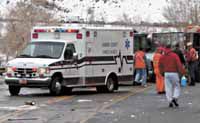| Unfortunately, ambulance personnel responding to local emergencies are relatively common occurrence in Carbon County. But fortunately, the county operated ambulance service recently expanded the level of patient care provided to by trained emergency medical technicians. |
Carbon County’s ambulance service has been looked at as a model for the rest of the state for some time.
Carbon runs the only rural county operated full-time with emergency medical technicians ready to respond from the center, as apposed to being on call and responding from work or home.
And the level of service just got better.
“We have increased our level of emergency patient care,” pointed out Don Marrelli, supervisor.
The supervisor explained that Carbon County’s ambulance service was previously at a level two, which means that it provided intermediate service. But the ambulance center recently advanced to intermediate advanced level.
In Utah, there are four levels of emergency patient care provided by ambulance services.
The five larger cities – Salt Lake, Provo, Ogden, Logan and St. George – all are at a four or the top level. The levels are based on care and services of local hospitals.
Until recently, most other smaller communities or counties in Utah provided basic or intermediate service.
Four members of the Carbon County ambulance crew began the advancement process in June 2002.
The local ambulance personnel attended a two-day course offered by the state of Utah. They were all trained by EMT instructors who prepared them to bring the material back to Price and Carbon County to the remaining ambulance crew members.
The four were Don Marrelli, Marty Wilson, Martin Wilson, and Joanne Bean. They became certified instructors and brought back the program to Carbon County, where they taught the program three days a week.
It took six months to run everyone through the advanced program.
Carbon County Ambulance service now provides the same initial service as the hospital in a full cardiac arrest situation in the home.
Marrelli explains that the ambulance service is bringing a new level of care into the home in an attempt to resuscitate more patients. The advantage is the time saved in the transport.
“Time is crucial in these life and death situations,” explains Marrelli. “Prior to the new level of service, we couldn’t provide this higher level of care.”
In the past, the medical care providers averaged one full cardiac arrest recovery in about every 100 attempts. But since the program has been implemented they have saved two lives in 13 attempts through home resuscitation.
“This shows great hope for our new program in saving lives,” said the county ambulance supervisor.
Marrelli explained that the volume of calls is larger in Carbon County than other rural areas, averaging 1,100 to 1,200 per year.
The local ambulance service has the support of all six emergency room physicians.
Without the support of emergency room supervisor Dr. Cam Williams, anesthesia supervisor Dr. Todd Johnson and chief nursing officer Terry Watkins, the level advancement would not have happened.
Marrelli also credited Carbon Commissioner Mike Milovich for his role in establishing the high level of service.
The training program was completed in July 2003 and the 17 members of the county’s ambulance crew traveled to northern Utah to take the state test.
Because of the criteria level of care, the standards are high.
The average number of people passing the program was 30 percent.
But all 17 Carbon County ambulance crew members passed, according to Marrelli.
The county ambulance supervisor said, of the 150 people who were tested last summer, only 32 passed and of these 17 were local.
Carbon County was unable to implement the program until Jan.1 because local officials were waiting for the state to provide the licensing criteria.
It had been approved by the Utah Lgislature last year, but did not go into effect until the 2004.
Once the new year rolled around the new intermediate advanced level went into effect.
“We are looked at as a model for the state,” explained Marrelli. “One more time to be the front runner in rural EMS (emergency medical services).”
Other ambulance centers contact the Carbon County service for insight into the new program.
All the EMTs are required by the state to recertify every four years, according to the ambulance supervisor. The EMTs have to prove their knowledge and competency to the state through a testing process The certification is created, implemented and graded by the state bureau of emergency medical services.
In Carbon County, however, Marrelli indicated that the ambulance service provides similar testing for local emergency personnel monthly.
The exam is a requirement of the Carbon County program to test for the advanced intervention status.
Carbon County has five fully equipped intermediate advanced ambulances to serve the community.

